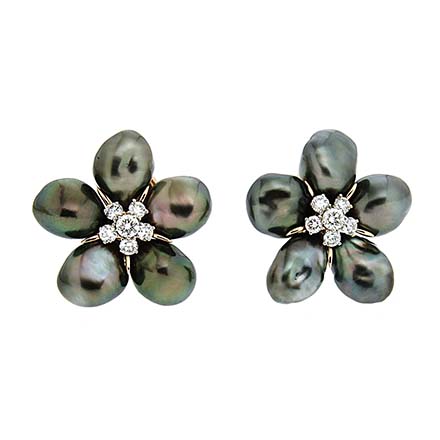As their name suggests, earrings are a type of jewelry worn on the ear. Though some designs are offered as single pieces or sets of three, most come in pairs. Earrings come in a variety of shapes, including hoops, spheres, and squares. Complex styles may include hanging elements, knots and interlocking pieces.
There is no set location for earrings. They may be anywhere on the external ear, with different names designating the location. In the United States, earlobes are the most common. While other types are specified as “cartilage piercings,” those on earlobes are just “piercings.”
When people think of earrings, they think of objects worn through the ear. Piercing is the act of puncturing a hole to create a place for jewelry to go. Earrings fastened with clips, adhesives or magnetic force also exist, but are less common.
The earliest known ear piercings hail from the Oztal Alps circa 3300 BCE. The oldest earrings found come from the Sumerian city of Ur around 2500 BCE. Gold was in short supply in Ur, leading artisans to pound the precious metal quite thin. These sheets were formed into hoops bottomed with hollow crescents which gave the impression of size.
Ancient Egypt also had remarkable earrings. In addition to gold, they were made of colored glass and carved stone. Archaeologists have found both hoops and studs from this civilization. Pharaoh Tutankhamun and this burial mask both have pierced ears.
While earrings were stylish for centuries, they fell out of popularity during the Middle Ages. Ear covering headdresses and hairstyles reigned. Few people were willing to wear jewelry hidden from sight. It would take until the sixteenth century for earrings to return to fashion.
During the eighteenth century, new developments in gemstones fueled earring designs. One was the discovery of diamond deposits in Brazil. The other was the advent of the old mine cut, which was brighter than previous diamonds. Earrings grew larger and took on more hanging elements to showcase more jewels.
The early Victorian era marked the return of ear-covering hairstyles. Earrings became long drops which hung beneath the hair. As tastes changed, ears were exposed once more and novelty designs were in vogue. People sought out earrings modeled after stars, flowers and even animals. Towards the end of the period, smaller pieces mounted with diamonds or pearls were favored.
The twentieth century cycled through a plethora of distinctive looks. Edwardian earrings adored diamonds, platinum and ethereal drops. Art Deco embraced carved gems along with diamonds, setting both in geometric designs. With retro earrings, bright colors and whimsical designs were the order of the day. Modern earrings follow no fixed style, but may be anything the designer or wearer desires.
Fasteners
There are several methods to keep earrings in place. The post and clutch is made of two pieces. Posts are a thin precious metal stem. The decorative parts are fastened to one end, while the rest goes through the ear. Clutches snap onto the tip of the post which protrudes from behind the earlobe, holding the arrangement in place.
Drop and other hanging earrings may employ hooks to thread through the earlobe. French hooks use thin wires long enough to make a clutch optional rather than required. A variant on the hook uses a hinged back which, when secured, forms a closed loop.
Some hoops are made to form a complete circle. To attach, a portion of the earring is much slimmer than the rest. This section is designed to swivel in and out of place for ease of wearing and removal. Behind it is a hollow portion of the hoop the wire fits inside. When secured, the fastener is invisible.
Not everyone is comfortable with piercing their ears. Clips use pressure to cling to the earlobe rather than use a hole. Most versions use a hinge to provide the tension needed to stay in place. Variants may use a screw mechanism for attachment.






